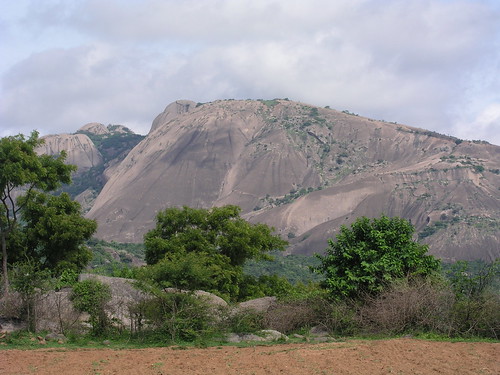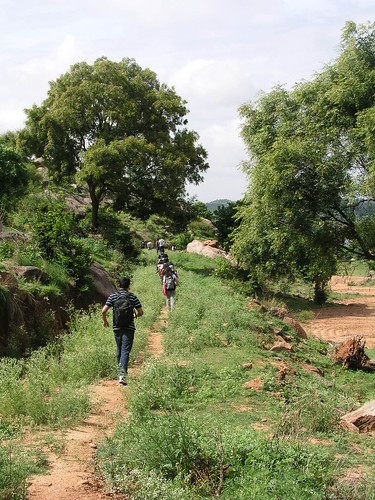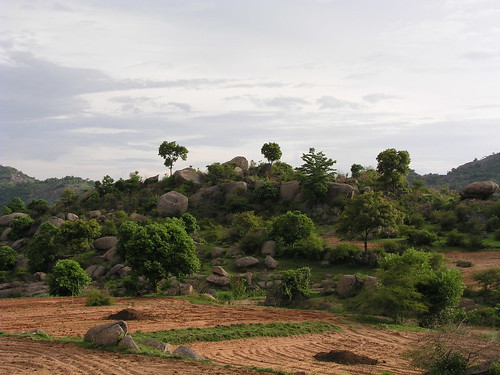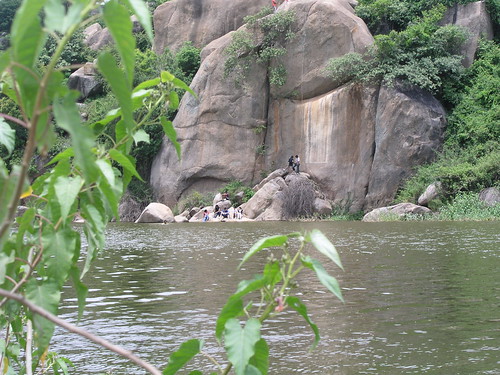
So I will totally spill the beans. The outing was arranged through Cox & Kings, which is an Indian travel and event service founded in 1758 (I think they must have evolved their business model a few times since then). Here is the description straight from the brochure circulated among the TWU organizers:
Mascal is a small village in the lap of Mother Nature having the world famous monolithic Savandurga opposite it with backwaters of Manchinbele Dam built on River Arkawati for fantastic Aqua recreation. It is around 45 kms from Bangalore towards the town of Magadi. The safe water body and terrestrial surroundings make it the best location around Bangalore for a perfect Adventure experience.
According to the preceding TWU lore, we were in for a long day of kayaking, rock-climbing, and team-building games. I was pretty cool with that as I really like outdoorsy stuff. And the views of the farm fields and hills on the hike in were magnificent. But it was also a little disturbing. It's not exactly clear where public and private land begins. We followed a narrow footpath through a carefully plowed and planted field and the farmer, poor man, was quite upset that these casual city people (Indians and foreigners alike) were trampling the new shoots. I was pretty bugged too.

My relatives were farmers and I have spent a lot of childhood days on farms; walking between, not on or over the rows, is a natural for me but much of our group seemed totally oblivious until I and some others called it out. The tour guides could have handled that better and given us a heads-up before we started. On the other hand, maybe there's a payoff to the farmer included in the deal, in which case, then the farmer was just maximizing his interest.
But again, looking at the plowed fields, the cattle, sheep and goats rambling about the slopes near the village, I wondered about agriculture encroaching into former wilderness and the soil and water degradation that follows. Not to mention the disturbance and loss of native plants and wildlife. These are valid concerns, too. Maybe it is not an issue with this one village but certainly these are issues elsewhere and that farmer's tensions about his crops are echoes of other tensions in India (and everywhere) about rivers and dams, heritage and progress, natural lands and urban space, water, food, pollution.

Anyway, the hiking was great, breakfast and lunch were ported over to the campsite by kayak and we trekked further into the rough to do some paddling, swimming and rappelling off a cliff. Except for me. When I packed for India, I carefully searched online for etiquette and clothing advice and came to the conclusion that I could survive the three-month assignment with one pair of jeans, several pairs of business-casual khakis and no shorts. So when the kayaks paddled up with about six inches of brown water sloshing around inside, there was no way I was going to sit down in that in my only change of clothes.
Instead, while the others swam or kayaked over to the opposite side where the cliff was waiting, I explored deeper into the near-side brush for some David Sibley-style birding. David Allen Sibley is a famous birder and bird illustrator who advocates finding a likely spot and sitting still for about two hours. I discovered this method myself when I was about 11 years old. It really works for high-quality nature experiences of all sorts, not just birds. But I had a great time watching a Pied Cuckoo, a Common Iora and a Little Spiderhunter get their morning meals.

Meanwhile, everyone else spent about as much time sitting around on top of the cliff waiting to get roped up and go over, or sitting around at the bottom of the cliff, waiting for a free kayak to paddle back. Except for the tough guys and gals who decided to swim instead of paddle. I shared my binoculars with them and we watched the cliff action for awhile - someone got their ropes askew and ended up hanging upside down for awhile. Another person turned out to have a fairly serious phobia and never stopped screaming until they were back on their feet at the landing spot. Everyone else who tried it went down the face smoothly and reported it was a great experience.
Later, on the hike back to camp, I was dive-bombed by a red-wattled lapwing guarding its nest. And at the campsite, there were many looks at oriental skylarks, laughing doves, a great gray heron and the lovely purple heron. Venu (TW IS guy) and I watched it through the binoculars for a long time. Venu also was the first to spot the little shrine or marker on the top of Savandurga . With binoculars, we could even see the visitors coming and going up there.
All in all, it was a fun day. After lunch, we hung out at the campsite and played games - frisbee, cricket, and team competitions like trying to guide the most blind-folded teammates through a maze. Team Biju rocked!
And then, the icing on the cake, on the bus ride back to the Diamond District, as we came into Bangalore, Venu pointed out the window to a dark patch in the night-time cityscape. "That is the racetrack," he said. "It's beautiful."
What! There's horse-racing in Bangalore? I had no idea! Now there's an idea for a new adventure!
You can find pictures of all of the birds mentioned here at this Birds of India website.
Click here to read Sharlene's post.
And click here to see what that other guy wrote.
No comments:
Post a Comment